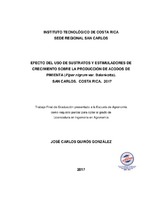Efecto del uso de sustratos y estimuladores de crecimiento sobre la producción de acodos de pimienta (Piper nigrum var. Balankotta). San Carlos Costa Rica. 2017
Resumen
En la finca Inversiones Agropecuarias Hermanos Quirós S.A., se llevó a cabo un ensayo con acodos de pimienta (Piper nigrum var. Balankotta) donde se evaluaron tres sustratos: suelo-aserrín, aserrín, suelo y dos estimuladores de crecimiento: Jumpstart, Trichoderma harzianum y su mezcla, con el objetivo de determinar el efecto de sustratos y estimuladores de crecimiento sobre la producción de acodos de pimienta. Para el análisis de los datos se utilizó un diseño de Bloques Generalizados con tres sustratos como factor de bloqueo y cuatro tratamientos. El Análisis de Componentes Principales se mostró que las variables evaluadas presentan un alto grado de importancia, que estas son determinantes para el análisis y no miden criterios similares; en el Análisis de Conglomerados se establecieron cuatro grupos, los cuales mediante el ANAVAM se determinó que existen diferencias estadísticas altamente significativas entre conglomerados (p= <0.0001), la prueba Hotelling mostró que todos los conglomerados fueron diferentes. El resultado estadístico por variable y conglomerado mostró que los conglomerados tres (suelo-aserrín-sin estimulador, suelo-aserrín-Jumpstart, suelo-aserrín-Trichoderma h.) y cuatro (suelo-aserrín-Trichoderma h.-Jumpstart, suelo-Trichoderma h., suelo-Jumpstart, suelo-Trichoderma h.-Jumpstart) en las variables largo de brote (p= 0.0011), cantidad de hojas (p= <0.0001) y peso aéreo seco (p= <0.0001), presentaron valores superiores a los conglomerados uno (aserrín-sin estimulador, aserrín-Jumpstart, aserrín-Trichoderma h.-Jumpstart) y dos (aserrín-Trichoderma h. y suelo-sin estimulador), para la variable cantidad de brotes no hubo diferencias estadísticas entre conglomerados (p= 0.1285); en cuanto a la variable peso raíz seco (p= 0.0030) los conglomerados uno y tres fueron superiores a los dos y cuatro. La mortalidad fue incidida por la presencia de cochinilla harinosa (Hemíptera: Pseudococcidae) y fue el conglomerado dos el que presentó los valores más altos. Se mostró un efecto positivo del sustrato suelo mezclado con aserrín, pero nulo en cuanto a los estimuladores de crecimiento en la producción de acodos de pimienta. In the farm Inversiones Agropecuarias Hermanos Quirós S.A., it was development an experiment about pepper’s layers (Piper nigrum var. Balankotta) where three substratum have been evaluated: soil-sawdust, sawdust, soil and two growing stimulated: Jumpstart, Trichoderma harzianum and their mix, with the objective to determine the effect of the substratum and growing stimulates over the production of the pepper’s layer. To analyze the data it was used a design of Generalized Blocks design with three substratum as a factor of dam and four treatments, in the Principal Component Analysis it was found that the evaluated variables present a higher level of importance, and this ones are essential for the analysis, and they do not consider similar criteria; in the Conglomerate Analysis it was establish four groups, they determinate through the ANAVAM the statistical differences existence that are highly significant among the conglomerates (p= <0.0001), the Hotelling test show that all the conglomerates were different. The statistical result per variable and conglomerate showed that the conglomerate three (soil-sawdust-no treatment, soil-sawdust-Jumpstart, soil-sawdust-Trichoderma h.) and four (soil-sawdust-Trichoderma h.-Jumpstart, soil-Trichoderma h., soil-Jumpstart, soil-Trichoderma h.-Jumpstart) in the variables of long sprout (p= 0.0011), amount of leaves (p= <0.0001) and the dry aerial weight (p= <0.0001), present superior values against the conglomerates one (sawdust-no treatment, sawdust-Jumpstart, sawdust-Trichoderma h.-Jumpstart) and two (sawdust-Trichoderma h. and soil-no treatment), for the variable of amount of sprout there was no statistical difference among conglomerates (p= 0.1285); about the variable of dry roots weight (p= 0.0030) the conglomerate one and three were superior against the two and four conglomerates. The mortality was introduce by the presence of cochinilla harinosa (Hemiptera: Pseudococcidae), and it was the conglomerate two that present the highest levels. There were a positive effect on the substratum soil mix with sawdust, but it was invalid on the growing stimulators in the production of pepper layers.
Descripción
Proyecto de Graduación (Licenciatura en Ingeniería en Agronomía) Instituto Tecnológico de Costa Rica, Escuela de Ingeniería en Agronomía, 2017


